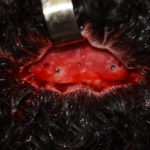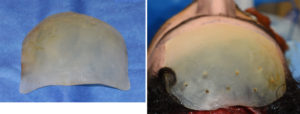The broad surface area of the forehead seems like a relatively simple facial area to augment. But in reality it is much harder to do so successfully than it appears. Getting the right implant shape and contour, having it blend smoothly into the upper temporal areas and not being overdone or looking unnatural are all potential aesthetic forehead augmentation issues. While the traditional use of PMMA bone cement for forehead augmentation has been done for decades, the intraoperatuve shaping of the material is prone to subsequent contour and shape issues.
In the November 2018 issue of the Aesthetic Surgery Journal, an article was published entitled ‘Integrated Forehead and Temporal Augmentation Using 3D Printing-Assisted Methyl Methacrylate Implants’ In this paper the authors reviewed two subsets of forehead augmentation patients. One group of thirty-four (34) patients over a ten year period had forehead augmentation with PMMA bone cement that was fashioned and cured during surgery. The subsequent group of forty-one (41) patients had a prefabricated PMMA forehead and temporal implant made from the patient’s 3D C scan. These two groups were compared based on their aesthetic outcome differences and similarities.
The prefabricated forehead augmentation group had a lower incidence of subsequent implant removal, a decreased need for subsequent filler injections and a higher overall aesthetic score than the traditional PMMA forehead augmentation group. Otherwise there were no differences in surgical complications between the groups.


Dr. Barry Eppley
Indianapolis, Indiana



